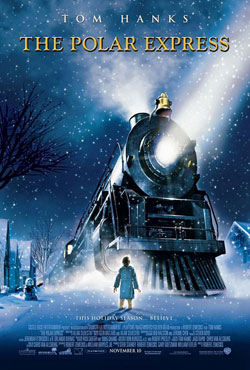 Into the breach goes Warner Bros, sending their mega-expensive adaptation of the beloved children’s book The Polar Express against the juggernaut that is Pixar’s The Incredibles. Of course this isn’t a blind shot – they do happen to have Tom Hanks in the film, in something like five roles. And he has reteamed with director Robert Zemeckis, with whom he made small films like Forrest Gump and Cast Away. And they do have an all-motion capture CGI film that is full of eerie realism.
Into the breach goes Warner Bros, sending their mega-expensive adaptation of the beloved children’s book The Polar Express against the juggernaut that is Pixar’s The Incredibles. Of course this isn’t a blind shot – they do happen to have Tom Hanks in the film, in something like five roles. And he has reteamed with director Robert Zemeckis, with whom he made small films like Forrest Gump and Cast Away. And they do have an all-motion capture CGI film that is full of eerie realism.
Hanks and Zemeckis came to New York to do some press, and here’s what happened. Note: It gets filthy at the end. Seriously.
Q: Mr. Hanks, this is your third CGI film. What do you get out of seeing your likeness in that format. And as a second part to that question, can you talk about continuing with a Toy Story 3 with Pixar?
Hanks: I don’t know. Quite frankly. The creative team that put together the original Toy Stories was quite specific and quite organic, I think. Not that there aren’t other talented people that would be involved. That would be a bridge I would cross when I come to it.
The aspect of looking at yourself in the Toy Story movies… it’s a little puppet. It sorta looks like me. But his head is like nine feet tall. The difference between that and The Polar Express is extraordinary because The Polar Express really is me, as opposed to some rendering of a character.
Q: What was it about the book that made you want to make it into a film. Also, what was your favorite book as a kid?
Hanks: The book itself, the 29 pages of it is a haunting story that you can’t quite put your finger on. I’ve been reading it to my kids since the book’s been published, and as you get closer and closer to Christmas you read it more and more. There’s something stunning , quite frankly, about Chris Van Allsburg’s paintings. They’re not drawings, they’re impressionistic versions of this child’s house and what it was like to be on a train and all the aspects of the adventure they went on. It was always a very tactile feeling that I got reading the book – as well as a very elegant but simple, yet complicated and sophisticated, story about what Christmas means to each and every one of us. The idea of that turning into a movie is a complete X-factor. You have no idea if it’s going to be possible or not, which is why when Bob and I first started talking about it, it was only from the perspective of “What do you think, is something possible here or not?”
Favorite books? When I was a kid, I loved reading Crime and Punishment by Dostoevsky.
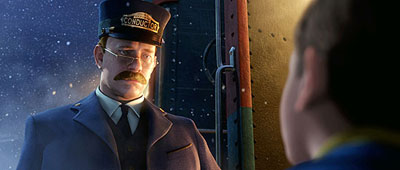
Q: Robert, what made you want to do this as CGI?
Zemeckis: One of the first things I said to Tom when he said what do you think, I said it wouldn’t make a very good live action movie, for a couple of reasons. One, it would be impossible – well, nothing’s impossible. It would cost billions of dollars, you could do it with enough money. Two, you would be throwing away what I call the essence of the book, which are those paintings. The paintings are where the emotion comes from in my opinion, and without those paintings you’re throwing the book away. The third problem would be hanging this giant film on a kid actor who you would have to go around the world for and hope you could find one. It’s always a problem, these movies with the young actors, you’ve got to hope you’ve got the next Haley Joel Osment.
Q: You open the Wall Street Journal and see the headlines saying that the film is risky. Can you speak about the risks in laying so much money on a project like this?
Zemeckis: I think you have to, at the end of the day – what those stories leave out is the screenplay. They talk about it like it’s some manufactured hardware product. I think that everybody who is involved in this movie from the studio to the creative team to the marketing, when they read the screenplay they said, “If you guys make this screenplay-“ and we did everything really responsibly, we did a minute and a half test of the system. Everybody at the studio looked at it and said, “This works, and if you make this screenplay-“ And what’s great about motion capture is that you spend twenty percent of your money and know what you’ve got where with live action you send actors and a director out and they spend eighty percent of the money and you don’t know if you have a movie there or not. So it’s very responsible, very controlled. And what we did is we realized the script that we said that we were. There was no problem.
Hanks: I think every one of these movies is an incredible risk. Because at the end of the day you don’t know if people are going to care. I think down through history – people were walking around going, “Let me get this straight – you’re going to make a movie about a monkey and you’re going to do it with a little clay figure one shot at a time. What a stupid thing! No one’s going to care about that.” And the movie is King Kong. Or George Lucas is making some rock em sock em space thing with guns and robots and everybody says, “Nobody’s going to care about that,” and it’s Star Wars.
The only thing that’s going to matter is the story. It’s not going to matter how expensive it is or how technological it is – that’s just the aspect of we had to figure out how to make the movie and that’s the way we made the movie. Is it a big risk? Sure, we could lose our shirts and people could lose their jobs – if the movie stinks. But that would be the same thing if it was a story about me and Nona Gaye driving in a car and talking to each other, if that stinks.
Q: Are you worried that motion capture will render actors obsolete?
Hanks: The nature of motion capture is only going to work for certain films. It’s not going to put any kind of movies out of business, and it’s been used in movies you thought were great – The Matrix, Titanic. It’s in countless movies, and it’s been used in the same sort of way. What this can do from an actor’s standpoint is free us up to a huge degree. I’ve used this analogy many times and I apologize to Meryl Streep, but she’s just the name that comes up: If Meryl Streep can perform the greatest Ghengis Khan in history, better than anybody else could play Ghengis Khan, Meryl Streep could play Ghenghis Khan. If James Earl Jones could play the greatest Mickey Rooney in The Mickey Rooney Story, James Earl Jones can now play Mickey Rooney in The Mickey Rooney story. There’s an extraordinary opportunity for actors to no longer be limited by size, weight, color of hair, gender or race. That’s actually really great news. But the fact is that it’s right now still pretty prohibitively expensive, and it’s still difficult for the computer to capture the essence of a man kissing a woman. All those dots would meet in the face and all a sudden the computer’s going nuts and there’s one big head that looks like a banana. There’s not even a way to do that yet. What this allows, I think from a filmmaker point of view, if they can imagine it, they can film it. As far as an actor goes, it’s possible now to play any character in any circumstance in a way that was not as feasible before.
Q: Did you find that it was hard to act with the motion capture process?
Hanks: I found as an actor it allowed a return to a kind of acting that film’s don’t allow you to do. It’s exactly like rehearsing a play in the round. You don’t have to worry about lights, angles, rails, over the shoulder coverage. We did a great series of ten or fifteen minute plays in which we did it real, did it real time, and when we were done Bob had everything he needed. As far as an actor goes it was a blast.
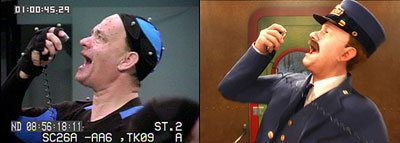
Q: This is a movie about the loss of innocence, and it doesn’t have a big villain. How do you think the kids will react to a movie without a bad guy?
Hanks: [puts his face in his hands] Isn’t every movie about lost innocence? It seems like everytime you make a movie about people who are innocent it’s about their lost innocence. It’s maddening.
I don’t think it’s about – it’s about belief. Everybody carries their belief around with them on their sleeve. It’s a very personal thing that can’t be described. When Bob began writing the screenplay, the idea that he had was to start the movie with the first line of the book and end the movie with the last line of the book and stay away from the standard antagonist/protagonist narrative, which is usually kind of a bullshit way to move the story along or bring jeopardy to it. I think the vast majority of the audience can see a formulaic narrative a million miles away, they’re tired of it, it’s very predictable. The reason you go to the movies is that you want to be surprised by a narrative that you don’t know where it’s going. We kept figuring out what not to do with the story as opposed to what to do. This all came out of the consciousness of Bob when he began digging into the material.
How come there’s no bad guys, Bob?
Zemeckis: Eh?
Q: Was there a steep learning curve with wearing the motion sensors?
Hanks: Bob gave us a seminar of whar we were supposed to expect, with the volume and the cameras and the things, and he talked to us for about three hours and I think we were still confused. [does a hilarious Zemeckis impersonation] “It’s gonna be GREAT! It’s gonna come in and yadda yadda computers and yadda yadda dolly tracks!” Then we did it for the first time and it was pretty great and we figured it out.
Q: If you rode the train, what would your ticket have said at the end?
Zemeckis: Having written the screenplay, mine would have said “Believe.”
Hanks: Mine would have said “Calm down.” “Don’t worry, be happy.”
Q: When did you decide to bring this to IMAX, and when did you decide to make it 3D?
Zemeckis: What’s wonderful about capturing a movie in three dimensions is that the decision was made in April or May. The IMAX movie is in 3D, so compared to mounting and producing a flat 3D movie as opposed to a 3D 3D movie, all you had to do was flip a switch.
Production finished and IMAX came to us and said they wanted to release the movie in IMAX. “How about 3D,” their guy said. Well, everything’s in 3D. So they did.
Q: Have you seen the 3D version?
Zemeckis: It’s fantastic. It’s better than any other 3D than I have ever seen because you can adjust the depth of field in each shot because everything is separate and digital, which you can’t do in real life because you’re hampered by light levels and depth of field. Every shot it perfect.
Hanks: And the glasses are really flattering. They make everybody look really cool.
Zemeckis: They look like the Lou Wasserman glasses.
Q: What are your holiday memories? And what is your favorite Christmas movie?
Hanks: I always took the Greyhound bus from Oakland California to Red Bluff California to go to my mom’s house. The day we’d get out of school we’d go to the Greyhound station and get on the bus for three and half to five hours, depending on if we were transferring at Sacramento or not. I’d have a little stack of comic books and would look forward to hopefully staying awake until we pulled into frigid Red Bluff and hopefully sitting next to some old lady who was passing out banana bread. Happened quite often.
My favorite traditional Christmas movie I like to watch is All Quiet on the Western Front. It’s just not December without All Quiet on the Western Front.
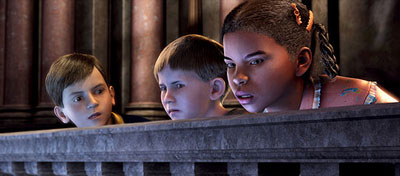
Q: Bob, after working on Roger Rabbit was this easier?
Zemeckis: Roger Rabbit was an insane endeavor. That was probably the hardest film I have ever made. This, in comparison, was a dream. Roger Rabbit had a team of animators that had to be directed for two years after we finished a live action film noir movie, and we walked away from every set-up hoping that it was right. It couldn’t be changed and decisions had to be made before you even saw the rabbit’s performance, where it took a year to get a minute of his performance. This was a complete dream because you got to direct in two phases. You got to work exclusively with the cast and work on their performance and only that, and then when we were done with that, in the comfort of an office you did the cinema part. It was just great. You didn’t have to worry about the elements, the rain, if the trucks would get stuck in the mud, if the generators would run out of gas. None of that. It was wonderful.
Q: But what ground did you have to break on this film?
Zemeckis: We had to perfect the system and we had to figure out what the limitations of it were, which aren’t that many. What we had to do was figure out how you take a traditional 2D movie and imagine an elaborate set, like the North Pole for example, and grid it down into ten by ten chunks of volume and make the movie in ten by ten pieces at a time. But once we had that laid out, it went like clockwork. If we were doing a scene in this ballroom, for example, you would have a crew come in and measure it in ten by ten squares. If I had an actor who had to walk from this end to that end, you do it in these increments. But now in the current motion capture film that’s being done the volume is twenty by twenty. It’s getting bigger.
Q: How was Chris Van Allsburg involved in this film?
Zemeckis: Chris was really supportive on this. He was really great. We spent a whole day where I acted the movie out for him. He was great. For him this was twenty years ago. He just listened and said, “Sounds great.”
What was important for him – Chris never wanted this an animated movie because you can imagine what that would look like. You couldn’t make those paintings look right in an animated cartoon. What he wanted was to make sure that the style of the movie had the same resonance as the paintings did. When we showed him the conceptual art he couldn’t be more thrilled. One of the things that the guys at Sony did, which I thought was great, was had him come down and give seminars to their artists so they could get an insight into how he painted, so they could render the movie as best as possible to look like his original art.
Hanks: I had read his other stuff prior to this, between Jumanji and The Garden of Abdul Gasazi – particularly Jumanji. That’s almost a scary book for me to read because it’s black and white and stark and it’s about these kids alone in a Manhattan apartment. The Garden of Abdul Gasazi is sort of the same. There’s this mystery – you can be afraid. They’re almost like these miniature Twilight Zone episodes – they’re more benign than Twilight Zone episodes but they’re still fraught with this kind of danger and power and jeopardy that’s inherent in all his stories. Then you meet him and he’s this kind of button down – he’s not a kooky artist who wears a beret and says, “Yeah man, I’m wild about those trippy wolves.” He’s actually kind of a straight guy who in this case was very open to the ideas. In this case it’s a 29 page picture book, and you have to do something different than what he did there. I think he’s a brilliant man.

Q: How do you keep your kids convinced that Santa Claus is still real?
Hanks: I flummox them with semantics.
“What’s your question?”
“Is there really a Santa Claus who delivers presents?”
”Let me get this straight. Do you go to bed on Christmas Eve?”
”Yeah.”
”Do you leave out the milk and cookies?”
”Yeah.”
“Are they gone in the morning?”
“Well, yeah.”
”Are there Christmas presents there that weren’t there the night before?”
“Yeah.”
”Well, what’s your point? You believe or not? Look. Santa doesn’t care if you believe in him or not – he just cares if you go to bed when I say so!”
Q: Tom, is it true that you’re related to Abraham Lincoln?
Hanks: [winks] We keep that quiet, but it’s absolutely true.
Q: Has it ever affected your career?
Hanks: Here’s the deal. I was in an audition for Bosom Buddies and there was a guy in there who was related to Stephen Douglas. Who got the job?
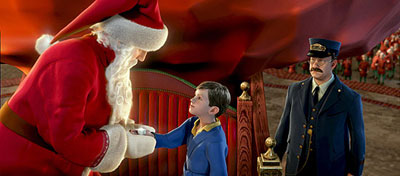
Q: How do you approach making a kids movie?
Zemeckis: I have a very simple philosophy when it comes to movies and kids. When I was a kid, I never wanted to see a movies that were made for kids. I wanted to see movies that were made for adults. I think that all the great kids films, like the ones Walt Disney was making, they’re all made for adults. My approach was to make this movie for adults, because the kids get everything. One thing they resent is the idea of being talked down to, so this idea of making a movie for kids – I just didn’t even go there. I just made the movie I thought I would enjoy, and other people would enjoy. Obviously you have boundaries because you don’t want the kids offended by the movie, or disturbed by the movie, but I wouldn’t even know how to begin making a movie kids would like.
Q: The film is rated G – did you aim for that rating? Do you see it as a problem?
Zemeckis: Uh, I don’t think it’s been a curse for Disney or Pixar or any of those companies. I never even thought about it. I can never figure out the ratings board no matter what I do. We made the movie, got a G and said, “That’s great!”
Hanks: I kept trying to say as the Hobo, “What the FUCK are you doing here?”
Zemeckis: I wouldn’t let him say that!
Hanks: He just kept making me do it again and again. Once I forgot to say “fuck” and now it’s rated G.
Zemeckis: We would have only gotten a PG-13 if he said it once, he needed to say it twice.
Hanks: I think Eddie Deezen was going to cut loose with some foul language. “I tell you this is a great motherfuckin’ train! This is the greatest fuckin’ train I ever rode! Jesus, this hot chocolate tastes like horseshit! Jesus Christ!”
Told you. The Polar Express opens Wednesday everywhere.